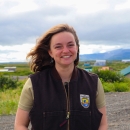Coastal brown bears on the lower Alaska Peninsula are some of the largest individuals and in one of the densest populations found in Alaska. The Joshua Green River watershed on the northeast side of Cold Bay supports the highest density of brown bears on Izembek National Wildlife Refuge and is used year-round as important natal grounds and denning habitat. Brown bears in this area have very small home ranges compared to other areas on the Alaska Peninsula because of high-quality habitat, abundant food, and low levels of human disturbance.
We've been conducting aerial brown bear stream surveys in Izembek Refuge since 1968, and on the nearby Unimak Island since 1988. Surveys are conducted annually in late summer, while salmon runs are at their peak and bears are feeding on salmon in the streams. During early morning and late evening flights, single bears, sows with cubs, and cubs are counted, and cubs are classified as either cubs of the year, yearlings, or 2 ½ year-old cubs. We use survey data to monitor trends in age composition, productivity, and minimum population count of brown bears in Izembek and nearby areas.



